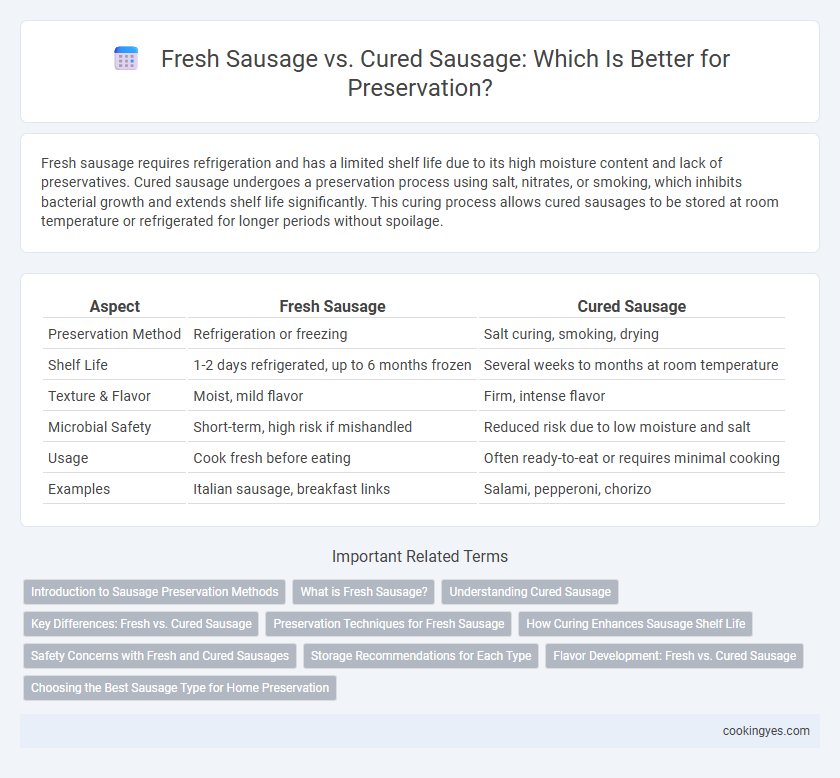Fresh sausage requires refrigeration and has a limited shelf life due to its high moisture content and lack of preservatives. Cured sausage undergoes a preservation process using salt, nitrates, or smoking, which inhibits bacterial growth and extends shelf life significantly. This curing process allows cured sausages to be stored at room temperature or refrigerated for longer periods without spoilage.
Table of Comparison
| Aspect | Fresh Sausage | Cured Sausage |
|---|---|---|
| Preservation Method | Refrigeration or freezing | Salt curing, smoking, drying |
| Shelf Life | 1-2 days refrigerated, up to 6 months frozen | Several weeks to months at room temperature |
| Texture & Flavor | Moist, mild flavor | Firm, intense flavor |
| Microbial Safety | Short-term, high risk if mishandled | Reduced risk due to low moisture and salt |
| Usage | Cook fresh before eating | Often ready-to-eat or requires minimal cooking |
| Examples | Italian sausage, breakfast links | Salami, pepperoni, chorizo |
Introduction to Sausage Preservation Methods
Fresh sausage contains raw meat and requires refrigeration or freezing to prevent spoilage, making it suitable for short-term storage and quick consumption. Cured sausage involves treatment with salt, nitrates, or other preservatives that inhibit microbial growth, allowing for extended shelf life without immediate refrigeration. These preservation methods balance safety, flavor development, and convenience in different culinary applications.
What is Fresh Sausage?
Fresh sausage is made from raw ground meat mixed with fat, salt, and various seasonings, without undergoing any curing or smoking process. It requires refrigeration and has a shorter shelf life, typically lasting only a few days when stored properly at temperatures below 40degF (4degC). Unlike cured sausage, which is preserved through methods like drying, salting, or fermenting, fresh sausage must be cooked thoroughly before consumption to ensure food safety.
Understanding Cured Sausage
Cured sausage undergoes a preservation process involving curing agents like salt, nitrates, and nitrites, which inhibit bacterial growth and extend shelf life significantly compared to fresh sausage. This method enhances flavor and texture while allowing the sausage to be stored without refrigeration for weeks or even months. Unlike fresh sausage, which requires immediate cooking and refrigeration, cured sausage offers long-term preservation and safety through chemical curing and drying techniques.
Key Differences: Fresh vs. Cured Sausage
Fresh sausage contains raw meat and requires refrigeration or freezing for preservation, typically lasting only a few days due to its high moisture content. Cured sausage undergoes a preservation process involving salt, nitrates, or smoking, which inhibits bacterial growth, allowing it to be stored at room temperature or refrigerated for extended periods. The key differences between fresh and cured sausages lie in their preservation methods, shelf life, and flavor development.
Preservation Techniques for Fresh Sausage
Fresh sausage requires refrigeration or freezing to maintain quality and prevent spoilage due to its high moisture and lack of preservatives. Vacuum sealing reduces oxygen exposure, slowing bacterial growth and extending shelf life. Using natural additives like salt, nitrates, and curing agents further inhibits microbial activity during short-term cold storage.
How Curing Enhances Sausage Shelf Life
Curing enhances sausage shelf life by inhibiting microbial growth through the addition of curing agents like sodium nitrite and salt, which create an environment hostile to spoilage bacteria. This preservation method also reduces moisture content, further slowing down bacterial activity and enzymatic deterioration. As a result, cured sausages can safely last weeks to months under refrigeration or controlled atmospheres, compared to fresh sausages that typically spoil within days.
Safety Concerns with Fresh and Cured Sausages
Fresh sausages require refrigeration and prompt cooking due to their high moisture content, which creates an environment conducive to bacterial growth, posing significant safety risks if not handled properly. Cured sausages undergo processes like salting, smoking, or fermenting that reduce water activity and inhibit pathogen proliferation, extending shelf life while enhancing safety. Despite these preservation methods, cured sausages must still be stored correctly to prevent contamination and spoilage from mold or Listeria monocytogenes.
Storage Recommendations for Each Type
Fresh sausages require refrigeration at temperatures below 40degF (4degC) and should be consumed within 1 to 2 days to prevent spoilage, or frozen at 0degF (-18degC) for up to 1 to 2 months for longer storage. Cured sausages, benefiting from salt, nitrates, or smoking processes, have extended shelf lives and can be stored in a cool, dry place for several weeks, with vacuum-sealed packaging extending freshness for months. Proper storage methods for each type are essential to maintain safety, flavor, and texture during their respective preservation periods.
Flavor Development: Fresh vs. Cured Sausage
Fresh sausage delivers a vibrant, meaty flavor with subtle herbs and spices, emphasizing the natural taste of raw ingredients. Cured sausage undergoes fermentation and aging processes that develop complex, tangy, and umami-rich profiles, enhanced by beneficial bacteria and extended drying times. The preservation method profoundly impacts flavor, with fresh sausage offering immediate freshness and cured sausage providing deep, concentrated taste through curing agents like salt, nitrates, and smoke.
Choosing the Best Sausage Type for Home Preservation
Fresh sausage requires immediate cooking or freezing due to its high moisture content, making it less suitable for long-term preservation compared to cured sausage, which undergoes salt curing and drying processes that inhibit bacterial growth. Cured sausages like salami or pepperoni have a longer shelf life and can be stored at room temperature after proper fermentation and drying, offering convenience for home preservation. Selecting the best sausage type depends on intended storage duration and available preservation methods, with cured varieties favored for extended storage without refrigeration.
Fresh sausage vs cured sausage for preservation Infographic

 cookingyes.com
cookingyes.com